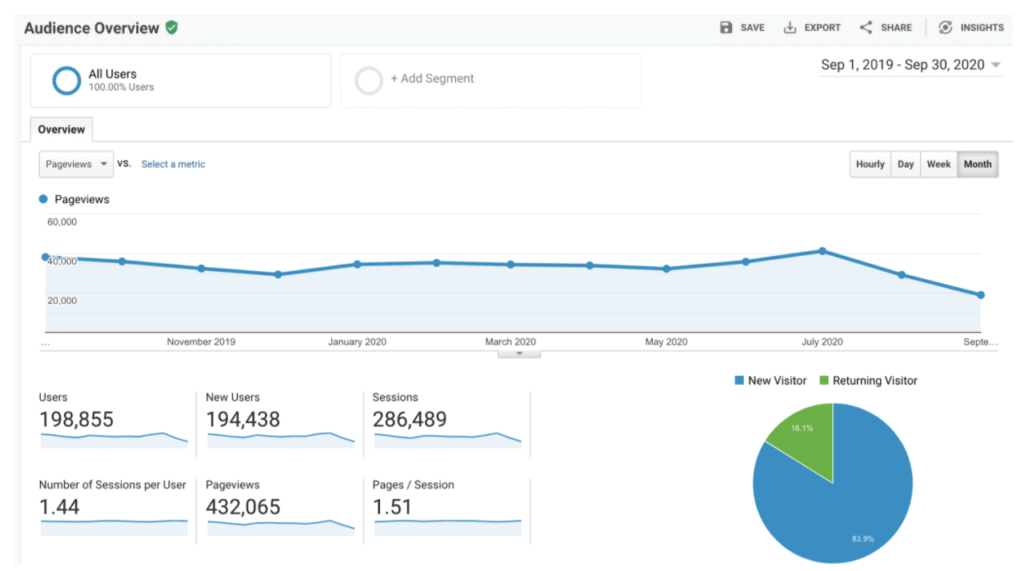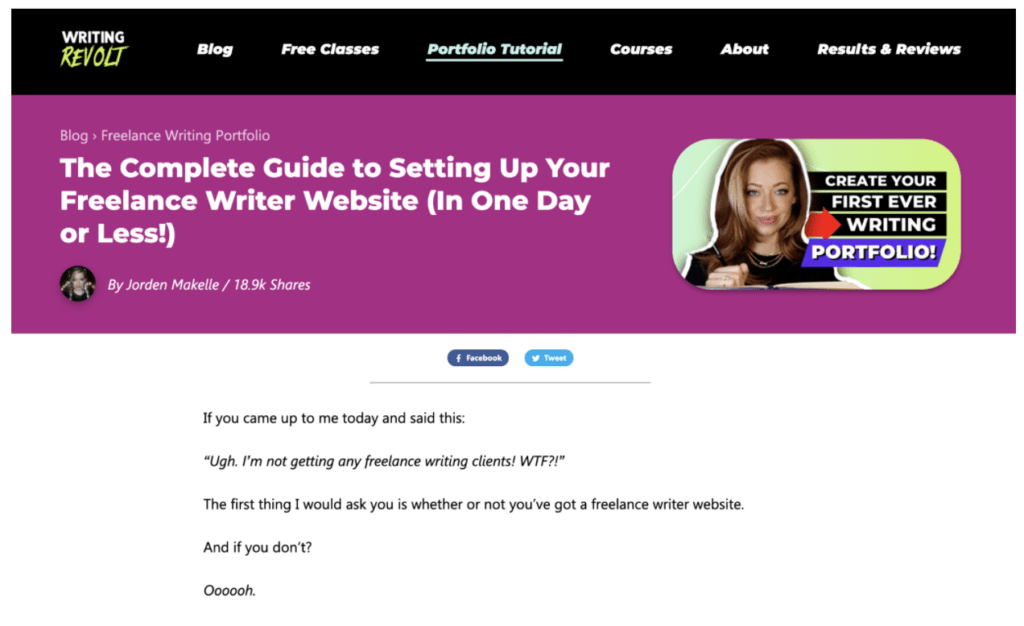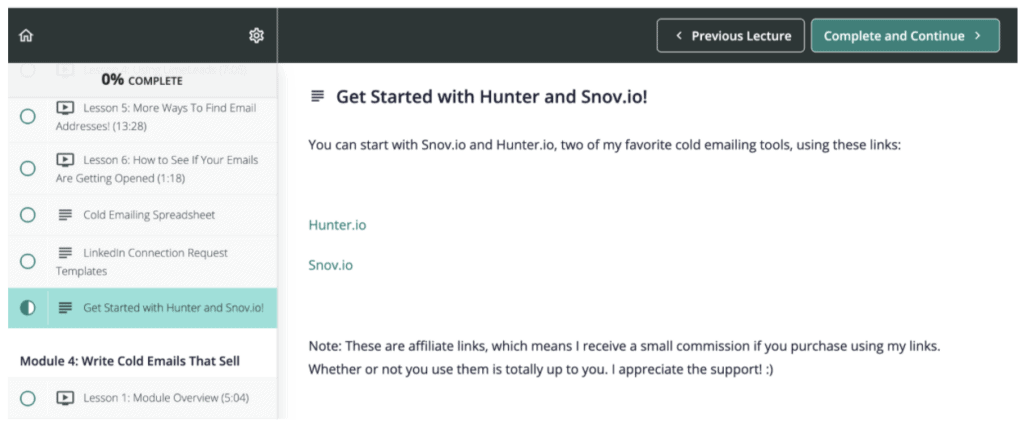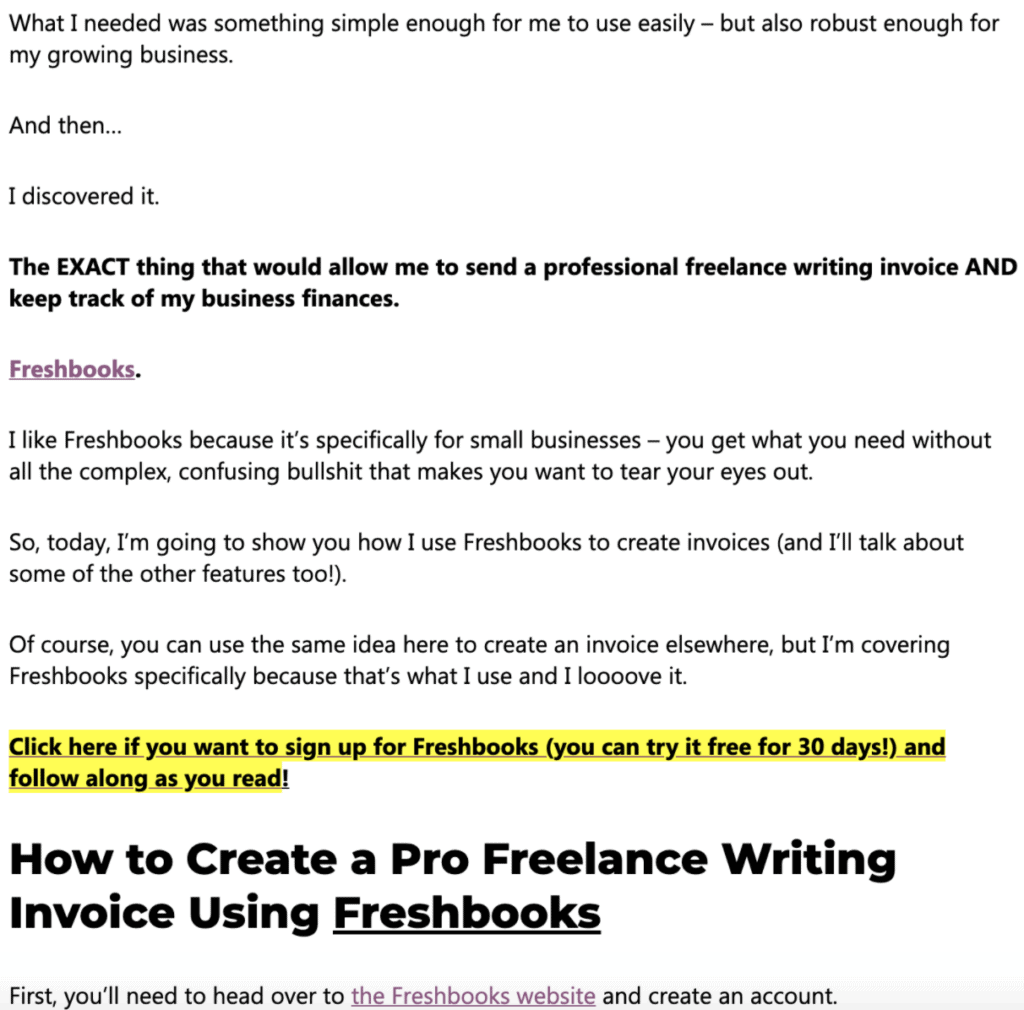Hello! Today I have a great article to share from Jorden Makelle, owner of Writing Revolt. Jorden is a student of my Making Sense of Affiliate Marketing course, and today Jorden is going to share how she made $59,977.50 through affiliate marketing on her blog in one year. If you do not have a blog…
Hello! Today I have a great article to share from Jorden Makelle, owner of Writing Revolt. Jorden is a student of my Making Sense of Affiliate Marketing course, and today Jorden is going to share how she made $59,977.50 through affiliate marketing on her blog in one year. If you do not have a blog yet, I recommend joining my free How To Start A Blog course. Enjoy!
When I started my blog in late 2015, I barely knew what affiliate marketing was. 
But when I learned that I could help my audience and create an extra income stream for myself just by promoting products I already used and loved, I realized…
It was a win-win situation!
So, I went all in.
These days, I’m able to bring in a steady revenue stream from affiliate marketing. In fact, my affiliate marketing efforts in one year – from July 2019 to July 2020 – resulted in about $59,000 in revenue.
Just as important, my audience is able to benefit from my recommendations, and I get to watch them succeed with the help of the same awesome products I’ve used to grow my business over the years!
Now, if you’re reading this as a beginner blogger, you may be wondering:
“How large of an audience do I need to achieve this?”
…And you’ll be relieved to know that you don’t need massive monthly traffic numbers or a huge audience to succeed.

What you do need is to follow the step-by-step process I’m outlining in this blog post, and with some focused time and effort, you’ll find you can achieve affiliate marketing success too!
How I Made $59,977.50 in Affiliate Income In One Year from a Small Niche Blog
Step One: Getting clear on my big-picture marketing strategy.
If you want to succeed with affiliate marketing, you need to get the fundamentals right first.
Make sure you’re clear on things like
- What exactly is your blog niche? Be specific, and make your niche evident throughout your blog website. The more clearly defined your niche is, the better your affiliate marketing efforts – and marketing efforts in general – will be.
- Who exactly are your target customers? Again, specificity is key here! For example, “people who want to learn yoga for flexibility” is better than “people who want to work out.” Really hone in on your audience’s specific wants, needs, and goals.
- How are you going to promote your affiliate links? You don’t have to know this in great detail at first, but you should have a general idea that you can refine later on!
My blog, Writing Revolt, helps freelance writers learn how to get clients – so my niche and audience is specific and defined.
I knew that, as an affiliate marketer, I wanted to help my audience out by sharing the best possible products related to writing and freelancing.
To take it a step further, I asked myself: “Within my niche and among my target audience, what are the biggest pain points I can help resolve as an affiliate?”
I then found products that alleviated those specific pain points, which is what we’ll cover in the next section!
Step Two: Analyzing my own favorite products.
To decide which products to promote, I first made a big list of all of the software products I found helpful in starting and growing my own freelance writing business.
Then, I researched to see which of those products had an affiliate program.
And finally, I listed out how I thought each of the products would help my audience overcome one of their pain points.
I made my decision about which products to promote after carefully considering each of these factors. Here are a few of the products and audience pain point alleviations I came up with:
- Bluehost for domain/hosting – My audience of beginner freelance writers often doesn’t want to spend a ton of money starting up their business and building a website. I can recommend Bluehost as a great option for getting it done on a budget.
- Freshbooks for easy invoicing – My audience wants a simple way to send pro invoices and track their income, and Freshbooks is excellent for exactly that.
- Divi WordPress theme – My audience doesn’t code (usually), so they need a simple way to build a site in WordPress, which they can achieve using Divi.
I have personally used and enjoyed each of these products, so I have always felt confident when recommending them.
Before we move on, an important note on ethics when it comes to affiliate marketing:
Do not recommend any product you cannot stand behind 100%.
As a blogger and YouTuber, I receive emails almost every week from random companies asking me to join their affiliate program and promote their products.
And to this day, I don’t think I’ve ever said “yes” to any of them. I only promote products I already use and enjoy myself.
The reason being:
I value my audience and their trust, and I never, ever want to compromise that, even if it means missing out on some extra revenue.
Make sure you’re valuing your audience over anything else as well.
Even if the results take a little longer to achieve, you can feel good knowing your promotions are truly ethical and helpful for your readers.
Step Three: Becoming an affiliate and building a relationship.
Now that you’ve chosen which products to promote, it’s time to become an affiliate! You can usually find a company’s affiliate program with some simple online research. If you don’t see instructions on their site, try a quick Google search like this:

From there, you should see how to sign up as an affiliate. Often, affiliate programs will ask you to submit an application before they will approve you, including information like:
- How you plan to promote the affiliate link
- The name of your business and your website URL
- Whether or not you agree to the Terms and Conditions of the affiliate program
Make sure you fill out the application completely. Also, read over the terms in full before you start promoting the affiliate link as some programs have specific rules for how to promote.
Once you’ve been accepted, you may receive an email from the affiliate program manager.
If that’s the case, be sure to respond in a friendly and courteous way, thanking them for getting in touch and letting them know you’re excited to start promoting their product.
Through my working relationship with my own affiliate managers, I’ve been able to get information on their special promotion time frames (for example, summer discounts they offer so I can share the discount with my audience during that time frame) as well as negotiate higher affiliate commissions.
Most affiliates won’t take the time to build a positive working relationship this way – but if you do, you can be sure you’ll set yourself apart, which can ultimately help you become a more successful affiliate!
Step Four: Creating and promoting evergreen blog posts for the right topics.
At this point, you should have a clearly defined blog niche/audience and active affiliate links you can share.
So, it’s time to start promoting those links!
To come up with the best possible content ideas, ask yourself:
“What specific pain point does this affiliate product resolve, and how can I create a piece of content that further resolves that pain point while sharing the affiliate link?”
For example:
When I started promoting Bluehost for website hosting and domains on my blog, I didn’t just throw around random blog posts about Bluehost and how to use it.
Instead, I got hyper-specific and created this evergreen, tutorial blog post that alleviated my audience’s main pain point in relation to Bluehost:
Creating a freelance writing portfolio website.

This blog post isn’t actually centered around promoting Bluehost. Instead, it’s an in-depth tutorial on exactly how to create a writing portfolio website, and Bluehost is just naturally recommended in the section about getting a domain and hosting.
As a result?
The blog post has directly resulted in thousands of dollars in affiliate income. And I get feedback all of the time from readers saying how the post helped them set up their writer website easily!
I’ve used the same approach promoting my affiliate link for Freshbooks, the invoicing software I enjoy, by sharing it inside of a freelance writing invoice tutorial.

While writing these blog posts, I made it my goal to create the most in-depth, detailed content possible on the topic.
That means that they include loads of screenshots, details, and step-by-step instructions to help my readers achieve their goals and overcome their pain points.
I’ve used SEO techniques as well as social media, especially Pinterest, to promote these blog posts and get traffic. And then, a percentage of that traffic will convert to affiliate sales.
The takeaway here:
Provide massive value within your content, and share your affiliate links naturally with a specific niche audience.
…Ideally, do this within tutorial-style blog posts that are as detailed and actionable as possible!
Step Five: Mentioning the affiliate products anywhere it makes sense.
I share my affiliate links within my online courses, my YouTube channel, and a resources section of my website.
For example, in my best-selling Killer Cold Emailing program, I teach students how to start a freelance writing business from scratch, focusing heavily on pitching and cold emailing.
This makes it easy to naturally share some of my absolute favorite cold emailing tools (and their affiliate links) within the course in a dedicated section, like this:

I’ve also experimented with emailing my audience tutorials and affiliate links directly, which has been effective as well.
More recently, I created a dedicated landing page with my favorite writing and business products/books (and their affiliate links) all in one place for easy reference.

Where you share the most successfully will depend on your business model and audience.
Analyze your own business, and ask yourself where it makes the most sense to share. Also, make sure you’re also following the terms for the affiliate program you’ve joined as some have rules about how you can and cannot promote.
If you want to learn step-by-step how to succeed with affiliate marketing, I cannot recommend Michelle’s affiliate marketing course enough. It’s super straightforward and actionable… basically, your ultimate guide to success with affiliate marketing!
Step Six: Tracking and improving results.
A few years back, I was bringing in consistent affiliate income every month, but I couldn’t help feeling that I could do so much better.
I set a goal:
I wanted to double my monthly sign-ups, without having to actively or heavily promote my affiliate products more than I already was.
To do this, I first researched to pinpoint the piece of content that was most successfully translating to affiliate sales for each product.
Once I found that piece of content, I asked myself:
“How can I optimize this content to sell even more effectively, without being too pushy or overdoing it?”
And my content optimization efforts eventually allowed me to reach my goal of doubling my average monthly sign-ups and majorly increase my revenue – just like I had planned!
So, how did I do it?
Well, one small change I made to increase conversions was highlighting affiliate links and related information in bright yellow within my blog posts.
Here’s how I did it in my freelance writing invoice tutorial blog post:

You can see that the highlighted text really pops here. It’s far more eye-catching that just a regular link, and is therefore more likely to convert.
I have definitely noticed a boost to my affiliate sales since doing this, so don’t underestimate seemingly small optimizations!
Sometimes, it’s not about making a major change or overhauling your strategy – it’s about taking what already works well, and making it work even better.
Also, keep in mind:
What you focus on is what will flourish.
For me, I had to set a clear intention to focus completely on improving my affiliate income for a set time frame. And during that time frame, that was my overall main business priority, whether that meant testing new approaches, optimizing my blog posts, or something else. I recommend you adopt a similar mindset to boost your own results!
Step Seven (Optional!): Negotiating higher commission rates.
Once you’ve started to get some results with your affiliate links, it might be time to try negotiating a higher commission rate, whether that’s a set dollar amount or a percentage.
I did this with one of my affiliate programs, and as a result, majorly boosted my income.
Think about it – even increasing your commission slightly can really add up and make a huge difference in your overall affiliate income. For example, if you’re getting 20 sales per month, even an extra $10 more per sale adds up to $200/mo, without you having to do anything extra!
Now, before you run off to send your negotiation email, you should know that there are some steps you need to take to make sure your efforts are successful.
Here’s what you’ve gotta do before negotiating:
- Set a goal and do your research. Try to find information online about popular affiliates for the program you’re in, and see if they mention their commission amount. If it’s higher than what you’re making, that’s a good sign the affiliate manager would be open to a negotiation! Set a goal for how much of an increase you want to ask for based on the numbers you find. If you can’t find any information, do your best to pick a number that excites you but is also realistic (in other words, don’t expect to jump from 20% commission to 90% commission!).
- Improve your results right before making the ask. The best way to get a “yes” when negotiating a commission increase is to prove you’re committed to getting better results! And the best way to do that is by showing proof of an upward trend in your sales. So, consider taking a month or two to really hone in on getting better results with that one specific affiliate link before you ask for a higher commission rate. Then, right when the top results come in, it’s time to negotiate.
- Have an already well-established relationship with the affiliate manager. Remember earlier when I talked about the importance of being friendly and establishing positive working relationships? Well, asking for a higher commission is one time that your relationship can majorly pay off! You’ll be far more likely to see a positive result from your negotiation if the affiliate manager already knows and likes you ahead of time, so keep that in mind and make sure to plan your negotiation accordingly. Simply being a kind and friendly human to those you work with is not only the right thing to do – it can also truly help you grow your business in an ethical way..
As you can see, a lot of negotiation success is dictated by how well you plan ahead. It’s not always about what you say in the moment (although that’s important too!) –– it’s what you achieve in the months leading up to the ask that makes the biggest difference.
If you’re scared to try negotiating, that’s understandable. But you shouldn’t let that hold you back! Check out this blog post for tips on negotiating successfully in spite of your fears.
Get out there, and start your own affiliate marketing journey!
Now that you know how to get started with affiliate marketing, it’s time to give it a try.
Remember that affiliate marketing, just like growing a blog or business in general, means playing the long game. Although you may not get massive results overnight, you can absolutely get incredible results from affiliate marketing with time – even if you have a small audience!
Take your time choosing the right affiliate programs, and remember:
When you genuinely care about your audience and consistently put out in-depth, helpful content, they’ll be more than happy to check out your affiliate links. It’s all about creating that win-win situation where your audience benefits from your recommendation, and you benefit as a business owner too!
Author Bio: Jorden Makelle is the owner of Writing Revolt, where she teaches freelance writers how to make a living online via her best-selling Killer Cold Emailing course. She has over 7 years of online marketing experience and enjoys songwriting, performing music, traveling full-time, and hanging out with her two spoiled Chihuahuas.
Do you have any questions for Jorden? What’s your favorite way to make money blogging?

